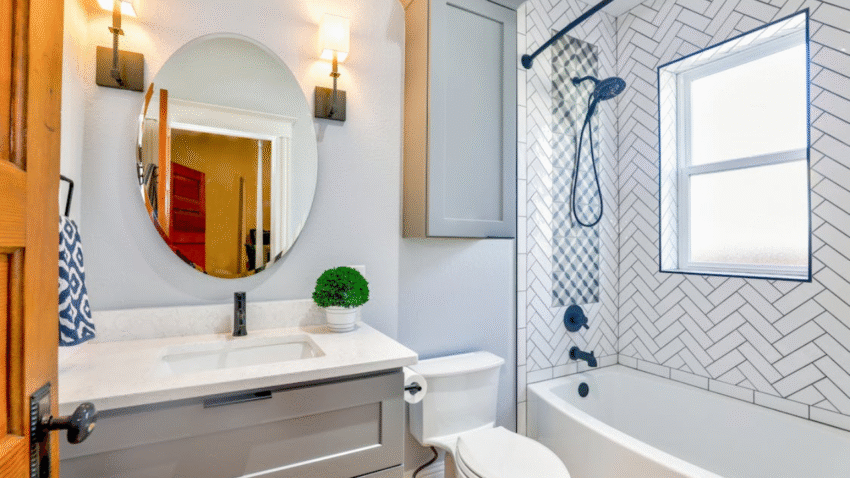Introduction
Is water pooling around your feet during showers? That’s a sure sign your drain is clogged. Learning how to clean a clogged shower drain is essential for keeping your bathroom functioning smoothly and preventing future plumbing headaches. This guide will walk you through simple tools, DIY methods, and step-by-step solutions to unclog your shower drain quickly and effectively.
Why Cleaning a Clogged Shower Drain Matters in the Bathroom
A clogged shower drain might seem like a small inconvenience, but it can turn into a bigger problem if ignored. Over time, hair, soap scum, and grime build up inside the pipes, reducing water flow and creating backups.
Cleaning your shower drain helps:
- Restore proper drainage
- Prevent foul odors caused by stagnant water
- Avoid water damage from overflow
- Eliminate breeding grounds for bacteria and mold
- Save money by reducing the need for costly plumbing services
Keeping your drains clear is key to maintaining a fresh and functional bathroom.
Step-by-Step Guide to Cleaning a Clogged Shower Drain
1. Remove the Drain Cover
Most shower drains have a removable cover to protect the pipe from debris. Depending on your shower design, the cover may:
- Pop off with gentle prying using a flathead screwdriver
- Unscrew with a Phillips head screwdriver
- Lift straight up if it’s a simple mesh grate
Once removed, wipe it down with hot, soapy water and set it aside.
Tip: Wear rubber gloves to avoid touching gunk or hair directly.
2. Pull Out Visible Hair and Debris
Using your hands (gloved), tweezers, or a drain cleaning tool, reach into the drain and remove as much gunk as possible. Hair buildup is often the main culprit.
- Use a flashlight to see inside the pipe
- Insert a hooked tool or drain snake to fish out deeper clumps
- Dispose of the hair in the trash, not back down the drain
Pro Tip: If you don’t have a drain snake, a straightened wire hanger with a small hook on the end can work in a pinch.
3. Flush with Boiling Water
Once you’ve cleared the top portion of the drain, pour boiling water slowly down the pipe. This helps dissolve soap scum and flush smaller blockages further down.
- Boil 1–2 liters of water
- Carefully pour it in small increments
- Wait a few minutes to see if drainage improves
Caution: Avoid using boiling water on PVC pipes—it’s safer to use hot tap water instead.
4. Use Baking Soda and Vinegar
This natural, chemical-free solution can help break down stubborn grime and odors inside your drain.
- Pour ½ cup of baking soda into the drain
- Follow with 1 cup of white vinegar
- Cover the drain with a plug or towel to trap the fizzing reaction inside
- Let it sit for 15–30 minutes
- Flush with more hot water
Bonus Tip: Repeat the process if water is still draining slowly.
5. Try a Plunger
If the clog is still present, using a plunger can help dislodge blockages further down the pipe.
- Place the plunger over the drain opening
- Add a little water to the shower base to improve suction
- Plunge up and down firmly for 20–30 seconds
- Check if the water begins to drain more freely
Plunger Tip: For best results, block the overflow vent (if present) with a wet rag to increase pressure.
6. Use a Drain Snake or Auger (if needed)
For deep clogs that aren’t solved with natural methods, a manual drain snake or auger can reach farther down the pipe.
- Insert the snake slowly into the drain
- Turn the handle to break up or grab the blockage
- Pull the snake back and clean off any debris
- Flush the drain with water to ensure it’s clear
Pro Tip: Use a plastic disposable drain snake for simple clogs, and a crank-style auger for tougher blockages.
7. Replace the Drain Cover and Clean the Area
Once the clog is cleared, rinse the drain cover and surrounding area with disinfectant. Reattach the cover securely.
Final Step: Test the drain by running water for 1–2 minutes to ensure smooth flow.
Common Mistakes to Avoid
1. Using chemical drain cleaners too often
These can corrode pipes and damage finishes.
Solution: Stick to natural or manual methods first.
2. Ignoring small clogs
A slow drain often means a clog is forming.
Solution: Address it before it becomes a full blockage.
3. Pouring grease or oil down the drain
These harden in the pipes and attract hair and debris.
Solution: Dispose of oils in the trash, not the drain.
4. Not cleaning the drain cover
Hair and soap buildup collect on the underside.
Solution: Rinse and scrub it every few weeks.
5. Pushing the clog deeper
Forcing tools without technique can worsen the blockage.
Solution: Use gentle motions and proper tools to avoid damage.
Extra Tips & Bathroom Hacks
🧼 Install a hair catcher:
Mesh or silicone drain protectors prevent most clogs before they start.
📅 Clean monthly with vinegar and hot water:
A routine flush keeps buildup from forming.
🪠 Keep a small plunger under the sink:
Easily accessible when slow drainage starts.
🧽 Use a toothbrush to scrub the inside of the drain cover:
It helps remove bacteria and soap scum from the edges.
👉 Related article:
Having plumbing issues? Check out our guide on how to fix a slow-draining tub.
Conclusion
Cleaning a clogged shower drain doesn’t have to mean calling a plumber. With the right tools and techniques—like pulling out hair, flushing with boiling water, and using natural solutions—you can get your drain flowing smoothly in no time.
Make it a habit to clean your drain monthly and use a hair catcher to prevent future problems. A clean drain means a clean shower—and a more enjoyable bathroom experience.
📌 Bookmark this guide so you can keep your bathroom fresh, clean, and problem-free all year round.
